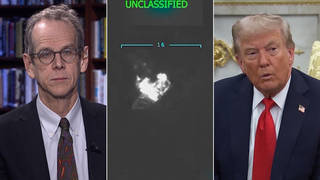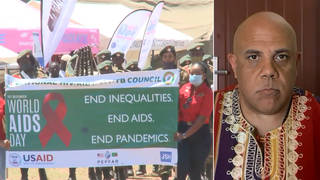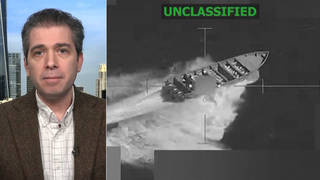
On Tuesday, the Bulletin of the Atomic Scientists reset the Doomsday Clock for 2023 to 90 seconds to midnight, warning the world is closer to global annihilation than ever before, in part due to Russia’s invasion of Ukraine. Since 1947, the Bulletin has maintained a Doomsday Clock to illustrate how close humanity is to the end of the world due to existential threats including nuclear war and the climate emergency. We speak with Frida Berrigan, longtime peace activist and nuclear weapons abolitionist, whose new cover story for In These Times is “How to Avoid Nuclear Stand-Offs That Threaten the Entire World.”
Transcript
AMY GOODMAN: This is Democracy Now!, democracynow.org, The War and Peace Report. I’m Amy Goodman, with Juan González.
The Bulletin of the Atomic Scientists is warning the world is closer to global annihilation than ever before, in part due to Russia’s invasion of Ukraine. Since 1947, the Bulletin has maintained a Doomsday Clock to illustrate how close humanity is to end of the world due to existential threats, including nuclear war and the climate emergency. On Tuesday, the Bulletin reset the Doomsday Clock for 2023.
BULLETIN OF THE ATOMIC SCIENTISTS: The members of the science and security board moved the hands of the Doomsday Clock forward, largely, though not exclusively, because of the mounting dangers in the war in Ukraine. We moved the clock forward, the closest it has ever been to midnight. It is now 90 seconds to midnight.
AMY GOODMAN: After the Doomsday Clock was reset to just 90 seconds to midnight, Rachel Bronson of the Bulletin of the Atomic Scientists spoke.
RACHEL BRONSON: Russia’s thinly veiled threats to use nuclear weapons remind the world that escalation of the conflict, by accident, intention or miscalculation, is a terrible risk. The possibilities that the conflict could spin out of anyone’s control remains high.
AMY GOODMAN: We’re joined now by Frida Berrigan, longtime peace activist and nuclear weapons abolitionist. Her new cover story for In These Times is headlined “How to Avoid Nuclear Stand-Offs That Threaten the Entire World.” She is the daughter of Liz McAlister and Phil Berrigan and the niece of the late Father Dan Berrigan.
Frida Berrigan, thanks so much for being with us. Talk about the Doomsday Clock.
FRIDA BERRIGAN: Sure. The Doomsday Clock was developed as a metaphor by the Bulletin of the Atomic Scientists in the late 1940s. It’s moved a number of times, maybe 30, 40 times in the last 70 years. This, as you have said, is the closest it’s ever been to nuclear midnight, just a minute and a half, 90 seconds.
And what’s striking about this is that, you know, we think about other hot moments in the nuclear age — the Cuban missile crisis, for example — the clock stood at seven minutes to nuclear midnight at that hot point, when, you know, people here in this country, people around the world really believed that a nuclear conflagration was imminent. And so, I think comparing it to the Cuban missile crisis is a good metric for understanding just how dangerous this moment is, with the confluence not only of the war in Ukraine but the proliferation of nuclear weapons throughout the world and the climate crisis all coming together. And the Doomsday Clock kind of takes those three — takes its measures from those three intertwining crises.
So, I am glad this is getting more attention. The Doomsday Clock is not always front-page news, although it ought to be. But this 90 seconds is a very dramatic wake-up call to the world that I hope many, many people are hearing loud and clear. The clock is ticking, and nuclear disarmament, nuclear abolition must be in the forefront of everyone’s mind in this moment.
JUAN GONZÁLEZ: And, Frida Berrigan, I wanted to ask you about what seems to me the perennial arrogance of political and military leaders to feel that you can wage these kinds of wars and control the possibility of them ending up with nuclear war, and the sense that war, once unleashed, can be controlled.
FRIDA BERRIGAN: Right, Juan. I think that that word is “arrogance,” right? And you said it. I think the United States has, because of the way in which we’ve invested in nuclear weapons, the hubris of using nuclear weapons, not once but twice in 1945, against the cities of Hiroshima and Nagasaki, nuclear weapons have insulated the United States ever since from the consequences of hegemony — right? — and the imperial project of the United States. And we continue, you know, today to pump tens of billions of dollars annually just into nuclear weapons. We’re always — the United States military and weapons contractors are always seeking to refine and further perfect the ability to end the world as we know it. And I think that at the height of arrogance in this moment is the notion of tactical small nuclear weapons, that we can control the blast, we can control the dissemination of radiation, and that there are usable nuclear weapons that we can — the United States can use in wartime and not feel the consequences of them back here in the United States. And this is a lie. This is a fabrication. This is a fantasy that is perpetrated by war planners here in the United States. And it’s very, very dangerous logic that carries on.
And so, I think at the end of the Cold War, the United States had a choice. It had a choice to either disarm completely, abolish nuclear weapons — and there was a global momentum behind that, the world calling out for global abolition of nuclear weapons — and instead, U.S. military planners and the weapons industry, this multibillion-dollar industry that’s so entrenched in American politics, decided to continue to make nuclear weapons relevant, so this vast apparatus of weapons contractors and laboratories, of Sandia, Lawrence Livermore, Los Alamos, that this would all stay, and we would continue to invest billions and billions of dollars in nuclear weapons, going forward. And I think this stands in opposition to this growing global consensus that we see in the Treaty on the Abolition — the Treaty to Prohibit Nuclear Weapons, that is gaining traction, more and more countries signing on every year. And there’s a reckoning coming for the United States and other nuclear weapons states as they stand against this global consensus for nuclear abolition.
AMY GOODMAN: Frida Berrigan, we thank you so much for being with us, longtime peace activist, nuclear weapons abolitionist. Her new cover story for In These Times is headlined “How to Avoid Nuclear Stand-Offs That Threaten the Entire World.” And she is author of It Runs in the Family: On Being Raised by Radicals and Growing Into Rebellious Motherhood.
This is Democracy Now! When we come back, the state of Florida has blocked a Black studies AP course from being taught. We will speak with the first openly gay state senator in Florida. Stay with us.












Media Options